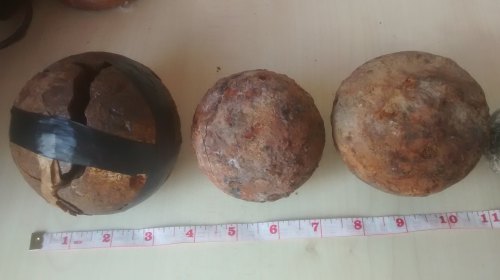
Image use policy
Our images can be used under a CC BY attribution licence (unless stated otherwise).
SHOT
Unique ID: MAS-100009
Object type certainty: Certain
Workflow
status: Published ![]()
This is an assemblage of six round cast iron and stone projectiles of varying sizes. Due to the ubiquitous nature of their design, it is difficult to accurately date cannonballs with any certainty. This issue is compounded by the wide variation in designs and calibres of the cannons that fired them and the lifespan of the weapon, with obsolete designs often still in use on merchant ships long after they had fallen out of service with the various navies of Northern Europe, who also used captured weapons on their vessels. Cast iron cannonballs are thought to have appeared at some point during the 15th century and were used as late as the last quarter of the 19th century, having gradually superseded stone cannonballs. By this time, rifled artillery had become the norm. From their general condition and flaking, these examples are heavily corroded. The round shot of speckled appearance could be granite, and may pre-date the cast iron round shot. An element of lead may also be involved in the manufacture of some of the shot in this assemblage.
The following potential identifications are based on the associated images for this record.
Images 1, 2 & 4:
Left: 4¼ inch iron cannonball, originally weighing approximately 10 pounds. A shot of this size may have been fired by a demi culverin. Demi culverin guns fired round shot of 4 - 4½ inch diameter weighing approximately 12 pounds (Collins 2016). The breaks may have happened after deposition due to the rusting and fracturing of iron.
Middle: 3¼ inch iron cannonball, originally weighing approximately 5 pounds. A shot of this size may have been fired by a saker. Saker guns fired round shot of 3 - 3¾ inch diameter weighing approximately 6 pounds (Collins 2016).
Right: 3¾ inch iron cannonball, originally weighing approximately 7 pounds. A shot of this size may have been fired by a saker. This is only a fragment of the cannonball, about two-thirds remain.
Images 3, 5 & 6:
Left: 2 inch stone shot (possibly granite), originally weighing approximately 1 pound. A shot of this size may have been fired by a falcon. Falcon ordnance of 2½ inch calibre fired round shot weighing approximately 1½ pounds (Collins 2016).
Middle: 1¾ inch possible lead alloy shot, originally weighing approximately 12 ounces. A shot of this size may have been fired by a base. Base ordnance of 1½ inch calibre fired round shot weighing approximately ½ a pound (Collins 2016).
Right: 1¼ inch possible lead alloy shot, originally weighing approximately 4 ounces. A shot of this size may have been fired by a musket. A musket is a long gun, fired from the shoulder, which is muzzle-loaded and has a smooth bore (Collins 2016).
Class:
Armour and weapons
Sub class: Ammunition
Subsequent actions
Current location of find: With finder
Subsequent action after recording: Submitted as wreck to the Receiver of Wreck
Wreck details
Droit number: 036/17
Chronology
Broad period: POST MEDIEVAL
Period from: POST MEDIEVAL
Period to: NINETEENTH CENTURY
Date from: Circa AD 1600
Date to: Circa AD 1875
Dimensions and weight
Quantity: 6
Discovery dates
Date(s) of discovery: Wednesday 14th September 2016
Personal details
Found by: This information is restricted for your login.
Recorded by: M F
Secondary identifier: V L
Other reference numbers
Droit ID: 036/17
Materials and construction
Primary material: Iron
Manufacture method: Cast
Completeness: Incomplete
Spatial coordinates
4 Figure: TQ8182
Four figure Latitude: 51.50793861
Four figure longitude: 0.60677648
1:25K map: TQ8182
1:10K map: TQ88SW
Display four figure position on What3Words
Grid reference source: From finder
Unmasked grid reference accurate to a 1 metre square.
References cited
- Collins AR, 2016. Miscellany: Historical ordnance. Internet : http://www.arc.id.au/Cannon.html, ,
Similar objects

Find number: MAS-F100104
Object type: SHELL CASES
Broadperiod: MODERN
The shell case measures 660 mm long and is 152 mm in diameter at the base, and 116 mm in diameter at the neck though this has been buckled and…
Workflow: Published![]()

Find number: MAS-D100048
Object type: CUP
Broadperiod: NINETEENTH CENTURY
Eleven teacups measuring 4 inches x 3 inches in size. The cups have a Chinese style design with a light grey colour pattern, and appear to be …
Workflow: Published![]()

Find number: MAS-D100180
Object type: CANNON
Broadperiod: POST MEDIEVAL
This item appears to be a small calibre black powder weapon, such as a swivel gun, commonly mounted on vessels throughout the age of sail as w…
Workflow: Published![]()







